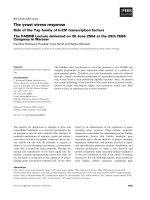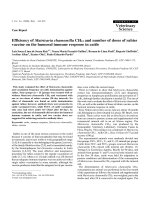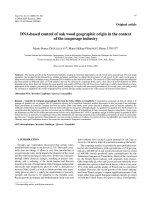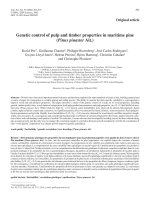DISSECTING THE HORMONAL CONTROL OF THE SALT STRESS RESPONSE IN ARABIDOPSIS ROOTS 2
Bạn đang xem bản rút gọn của tài liệu. Xem và tải ngay bản đầy đủ của tài liệu tại đây (6.91 MB, 74 trang )
!
87!
!
Chapter 4 RESULTS AND DISCUSSION 2
!
88!
!
4.1 Abstract!
High salinity is an important agricultural contaminant that causes damage to the plant.
However, the distinctive roles of different cell types in the transition process from normal
growth to stress acclimation are largely unknown. Here, we show that ethylene promotes
radial expansion of cortex cells through the canonical ethylene signaling pathway, while
its precursor ACC may have an ethylene-independent function of inhibiting cell
elongation during salt stress. By using mutants that have radial patterning defects, we
show that salt-mediated induction of ethylene biosynthetic pathway members at the
transcriptional level depends on the endodermis. In order to find the components that
work downstream of ethylene in regulating salt-mediated cell swelling, we performed
microarray experiments with ethylene signaling mutants at early stages of salt stress.
Bioinformatic analysis revealed cell-type specificity in the expression pattern of the
downstream targets of ethylene during salt stress, indicating the cell-type specific
function of ethylene in regulating the salt response. Further, we demonstrated that local
synthesis of auxin in the early elongation zone serves as a downstream component of
ethylene signaling during salt stress. Based on these observations, we that ethylene
promotes salt-mediated cortical cell swelling through auxin signaling in an endodermis-
dependent manner.!
!
!
!
!
!
89!
!
4.2 Introduction!
Plants, through intricate compositions of cell and tissue types, are good planners. In
favorable habitats, they plan their lives in a simple and effective way. However, when
they are facing stressful environments, they need to quickly coordinate their different
tissue layers, conduct complex regulation to change their developmental and
physiological plane to adapt to such environments. Salt stress is one of the most common
environmental stresses. It creates both osmotic and ionic stress to affect plant growth.
Decades of research into the effects of salinity on plant physiology and development have
generated a wealth of information. However, the distinctive roles of different cell types in
the transition process from normal growth to stress adaptation are largely unknown. In
this study, we used a particular salt-sensitive plant, Arabidopsis thaliana, focusing on one
environmental stress, high salinity, in order to understand how plants make this transition
and how different cell types contribute to this process. !
!
High salinity has complex effects on root physiology. These effects are mainly caused by
both osmotic stress and ionic stress. When the rhizosphere soil is contaminated with toxic
soluble molecules, like NaCl, the water potential of the soil become lower, making it
more difficult for plants to take up water from the environment. When the cells are
suffering from dehydration, the turgor pressure of the cells against their cell walls is
reduced, which can reduce the rigidity of plants and make them more vulnerable to
wounding. Along with water deprivation becoming more and more severe, many
biological processes, such as photosynthesis, are disrupted (Allen et al., 2001).
!
90!
!
Furthermore, due to their similar chemical properties, the high amount of Na
+
will break
the K
+
/Na
+
balance, leading to K
+
deprivation by engrossing ion channels, which are
normally used to transport K
+
into the cell (Rubio et al., 1995). It has been shown that K
+
is crucial for the activity of many enzymes; lack of K
+
will largely affect plant
development and growth (Shabala et al., 2008). !
!
When exposed to salt stress, the Arabidopsis root undergoes dramatic morphological
changes, which include the inhibition of primary root elongation, reduction of meristem
size, and inhibition of lateral root formation in a dosage-dependent manner (Burssens et
al., 2000; West et al., 2004; Wang et al., 2009). Besides generally affecting root growth,
high salinity also leas to cell type–specific morphological changes. For example, the
epidermis shows an immediate suppression of hair outgrowth, whereas the cortex
undergoes radial expansion, which may act to prevent additional uptake of salt into the
vasculature (Burssens et al., 2000; Dinneny et al., 2008; Dinneny, 2009).!
!
It has been shown that high salinity increases ethylene production (Achard et al., 2006).
Interestingly, like high salinity, ethylene and its precursor ACC can also inhibit root cell
elongation and promote cell radial expansion. Previous studies have shown that ethylene
regulates root growth, especially through the inhibition of cell elongation. This occurs
largely through the production and transportation of another important phytohormone,
auxin (Ruzicka et al., 2007; Swarup et al., 2007). However, there is a report showing that
the canonical ethylene signaling pathway may not be necessary for promoting radial cell
!
91!
!
expansion. This report suggested that ACS5, a member of ACS family, can regulate
radial cell expansion by directly binding to two leucine-rich repeat receptor kinases, FEI1
and FEI2 (Xu et al., 2008).!
In this study, by focusing on one particular morphological change, cortical cell swelling
during salt stress, we provided a detailed analysis on the distinctive functions of different
cell types in this process. We show that the endodermis is important for the promotion of
ethylene production by salt. The epidermis is crucial for the activation of auxin
biosynthesis by the canonical ethylene signaling pathway in order to promote cell
expansion during salt stress. We also show that ethylene signaling target genes that are
enriched in cortex that may be directly involved in regulating salt-mediated cell
expansion. !
!
!
!
!
!
!
!
!
!
92!
!
4.3 Results!
4.3.1 During salt stress, Arabidopsis roots undergo dramatic morphological
changes!
As shown previously, Arabidopsis roots gradually stop growing and stay in a quiescent
state for approximately four hours after salt treatment. With confocal microscopy, we
were not able to observe any significant morphological changes in the time point before
four hours (Figure 16A, B, and C). In the quiescent stage, cells in the outer tissue layers
(including the epidermis, cortex and endodermis), exhibited radial expansion in the early
elongation zone. The early elongation zone refers to the boundary of the meristematic and
elongation zones in roots. Among those layers, the cortex showed the most dramatic cell
shape change (Figure 16A). Along with radial cell expansion, the roots bend at the
elongation zone and grew into other directions (Figure 16A, C). Correlated with the event
of roots recovering growth rates in the homeostasis phase, the inhibition of cell
elongation was partially released (Figure 16A). Due to the rigidity of plant cell walls, all
of these morphological changes are irreversible after the cells enter into the maturation
zone, allowing us to observe them after they occur (Figure 17A). Among these
morphological changes, the inhibition of cortical cell elongation and radial expansion
were very consistent, easy to observe with microscopy, and quantifiable. Figure 17 shows
quantification of cortical cell length (Figure 17B) and cell width (Figure 17C) along the
longitudinal axis from the transfer point to the root tip. From the transfer point, the first
four cells gradually become shorter, while the cell width of the first four cells largely
remained unchanged (Figure 17B and C). This indicates that the inhibition of cell
elongation may happen earlier than radial expansion during salt stress. When comparing
!
93!
!
Figure 17B to Figure 3B, we found the primary root growth pattern and the profile of cell
length shared a certain level of similarity. This suggests that inhibition of cell elongation
contributes to inhibition of growth during salt stress.!
We next focused on cortical cell shape changes to understand the roles of different cell
types in acclimation during salt stress. To simplify the analysis, we used the ratio
between cell width and cell length (Figure 17D) of the 10 cells that showed the most
dramatic cell shape changes (Figure 17B and C, marked in grey) to represent the cortical
cell shape changes.!
!
94!
!
Figure 16. Arabidopsis roots undergo drastic cell shape changes during salt stress.
A) Plasma membrane marker WAVE131: YFP showed morphological changes in
Arabidopsis roots at different time points during salt stress. Yellow arrows point
at the first cell undergoing ectopic radial expansion. Noted after 4 hours of salt
treatment, the cells in the early elongation zone started to expand radially. Scale
bar= 200 µm.
B) Cortical cell length from quiescent center to elongation zone.
!
95!
!
C) Cortical cell width from quiescent center to elongation zone. Cell width increased
in the early elongation zone after 4 to 5 hours of salt treatment.
Figure 17. Cell shape change is irreversible due to the rigid plant cell walls.
A) Salt-mediated cortical cell swelling is easy to observe under confocal microscopy.
FM 4-64 was used as counterstain to highlight the cell shape.
B) Quantification of cortical cell length from the transfer point. Grey area highlights
the cells that are most strongly affected by salt.
!
96!
!
C) Quantification of cortical cell width from the transfer point. Grey area highlights
the cells that are most strongly affected by salt.
D) Phenotype was presented as the ratio between cell width and cell length of those
cells that show most dramatic changes. Error=SEM.
4.3.2 Ethylene is involved in the morphological changes of the roots during salt
stress. !
Ethylene and its precursor ACC have been described to cause an increase in the width of
the root (Smalle and Van Der Straeten, 1997) and a rapid decrease in cell elongation (Lee
et al., 2001). To test if the ethylene precursor ACC can cause morphological changes in
cortex cells similar to those caused by salt treatment, we treated Arabidopsis wild type
Columbia-0 (Col-0) seedlings with 140mM NaCl and different concentrations of ACC.
As shown in Figure 18A, ACC can cause a concentration-dependent effect on cortical
cell swelling: from 0.5 µM to 1.3 µM, ACC can cause very similar cell shape changes
with 140mM NaCl. As mentioned before, high salinity elevates ethylene production
(Achard et al., 2006). It is possible that the cortical cell swelling under high salinity is
due to elevated ethylene production. !
To test this hypothesis, we treated Col-0 with amino oxyacetic acid (AOA) in the
presence or absence of 140 mM NaCl using methods similar to the previous experiment.
AOA inhibits enzymes that require pyroxidal phosphate, including ACS, the key enzyme
for ethylene biosynthesis The results are shown in Figure 18B. Compared to seedlings
under salt treatment alone, there was a significant reduction in cell swelling in the
seedlings that were treated with both salt and AOA. Together with the results from the
!
97!
!
previous experiment, this indicates that ethylene production has a function in salt-
mediated cortical cell swelling. !
!
Figure 18. Ethylene is a potent cell shape regulator that may be involved in salt-mediated
cortical cell swelling.
!
98!
!
A) ACC shows a concentration-dependent effect on cell shape. Noted that the effect
could be saturated since 1.3µM ACC caused less cell swelling than 1 µM ACC.
B) ACC synthase inhibitor AOA is sufficient to decrease salt-mediated cell swelling.
Asterisks represent significant differences based on Student’s t-test. P value<0.05.
FM 4-64 was used as counterstain to highlight the cell shape. Grey arrows point to the
cortical cell file. Scale bar= 50µm.
It has been reported that the canonical ethylene signaling pathway might not be necessary
for promoting cell radial expansion (Xu S et al., 2008). To test if ethylene signaling has a
function in promoting cortical cell radial expansion, we investigated the inhibition of cell
elongation and cell radial expansion separately in etr1-1, ein2-1, and ein3-1/eil1-1. As
shown in Figure 19, all three of these mutants showed significantly reduced radial
expansion compared to wild type after salt stress. Surprisingly, we found that all three
mutants had normal salt response in terms of the inhibition of cell elongation, indicating
that mutations in these three ethylene signaling components cannot affect cell elongation
during salt stress. !
One possible explanation is that the canonical ethylene signaling pathway is required for
promoting radial cell expansion, but ethylene or ACC regulates cell elongation through
an alternative signaling pathway. It is also possible that ethylene has a function in
promoting radial cell expansion, while ACC regulates cell elongation in an ethylene-
independent fashion. !
!
99!
!
!
100!
!
Figure 19. Mutations in the genes that are involved in ethylene canonical signaling
pathway impair salt-mediated cortical cell radial expansion but not inhibition of cell
elongation.
A) etr1-1 shows less cell radial expansion, but similar rate of cell elongation
compared to wild type.
B) ein2-1 has similar phenotype with etr1-1 mutant.
C) The cell radial expansion phenotype in ein3-1 / eil1-1 double mutants is less
severe than in etr1-1 mutants, but the difference between wild type and ein3-1 /
eil1-1 is still significant.
FM 4-64 was used as counterstain to highlight the cell shape. Grey arrows point to the
cortical cell file. Scale bar= 50µm. Error= SEM. Asterisks represent significant
differences based on Student’s t-test. P value<0.0001.
!
101!
!
4.3.3 Salt promotes cell swelling by elevating ethylene production!
4.3.3.1 Salt enhances ACSs expression!
We investigate how salt regulates ethylene production. ACC synthase is the rate-limiting
enzyme in the ethylene synthesis pathway. The ACC synthases form a large gene family,
most of whose members have been found to function in a spatial- and temporal-specific
manner in response to many environmental stimuli (Tsuchisaka A, et al., 2004). By using
the spatio-temporal transcriptional map of salt response, we found that out of eight
functional isoforms of ACS (Tsuchisaka A, et al., 2009), four isoforms were responsive
to salt treatment: ACS2, ACS6, ACS7 and ACS8 (Figure 20 A to D). As shown in Figure
20 A to D, their spatio-temporal expression patterns were all different from each other. In
addition, different tissue layers showed different responses to salt. For example, ACS2
showed a strong decrease in expression in the endodermis after 3 hours of salt treatment;
however, in the stele the expression gradually increased until 8 hours of salt treatment. In
order to profile their expression patterns at the organ level at different time points, we
validated the microarray data by Q-PCR with whole roots. As shown in Figure 20 E to H,
we found that ACS2 expression is activated by salt in the early stage of salt stress; the
expression of all four genes was immediately increased after one hour of salt treatment.
These results suggest that the increased expression of the ACS genes could contribute to
the elevated ethylene production under salt stress. !
!
102!
!
Figure 20. The expression of ACS2, ACS6, ACS7 and ACS8 is regulated by salt in a
spatiotemporal fashion.
A-D) eFP representation of expression for salt responsive ACSs. They all have higher
expression level in the inner tissue layers.
A) ACS2, AT1G01480. Noted that this gene is highly enriched in endodermis.
B) ACS6, AT4G11280
!
103!
!
C) ACS7, AT4G26200
D) ACS8,!AT4G37770
E-H) Q-PCR validation with whole root samples for salt responsive ACSs.
E) ACS2, AT1G01480.
F) ACS6, AT4G11280
G) ACS7, AT4G26200
H) ACS8,!AT4G37770
!
104!
!
4.3.3.2 The endodermis is crucial for cortical cell swelling by mediating ethylene
production at the transcriptional level during salt stress !
Although the expression patterns of the four salt-responsive ACS genes show distinctive
spatio-temporal profiles, ACS isoforms function redundantly (Tsuchisaka A, et al., 2009).
It is possible that even a multiple-mutant of all four salt-responsive ACS genes would not
show any phenotype during salt stress. We wanted to test if altered root tissue patterning
could change the expression pattern of the ACSs which could lead to altered ethylene
production. If elevated ethylene production during salt stress is responsible for cortical
cell swelling, we may see different levels of cortical cell swelling under salt stress when
modulating root tissue patterning.!
Here, we utilized two mutants that have defects in root radial patterning, shortroot (shr)
and scarecrow (scr
)
. Figure 21A shows a diagram of the root structures of wild type and
these two mutants. Instead of two layers of ground tissue, these two mutants only have
one, which is called the mutant layer. In scr, the mutant layer has a mixture of cortical
and endodermal identities; in shr, the mutant layer has cortical identity, and as a
consequence, this mutant lacks an endodermis!(Di Laurenzio et al., 1996). We first
checked the cell swelling phenotype in these two mutants, as shown in Figure 21B.
Although the roots of these two mutants have very similar radial structures, they have
very different responses to salt in cortical cell swelling. Compared to wild type, the shr
mutant showed a significant reduction of cortical cell swelling.
!
105!
!
Figure 21. Endodermis is important for salt-mediated cortical cell swelling.
A) Diagram of Col-0, scr, shr radial section.!
B) shr-salk shows less cell swelling phenotype, while scr-3 mutant has a very
different response to salt, indicating the lack of an endodermis but not the presence of
only one layer of ground tissue caused less cell swelling. !
FM 4-64 was used as counterstain to highlight the cell shape. Grey arrows point to the
cortical cell file. Scale bar= 50µm. Asterisks represent significant differences based
on Student’s t-test. P value<0.0001. Error= SEM.
!
106!
!
As we expected, we found ACS2, ACS6, ACS7 and ACS8 were mis-regulated in the shr
background (Figure 22). ACS2 and ACS6 have impaired responses to salt in the mutants;
while ACS7 and ACS8 were expressed higher under standard conditions, and repressed
instead of activated by salt in the shr background. !
Since SHR is a transcription factor, it is possible that SHR might directly regulate these
salt-responsive ACSs. However, none of these genes are direct or indirect targets of SHR
(Levesque et al., 2006). These results suggest that the spatial information, but not the
SHR protein itself, is crucial for ACS2, ACS6, ACS7 and ACS8 responding to salt stress.!
The abundance of ACS transcripts is lower in shr during salt stress, which could lead to
lower production of ethylene. In order to test whether the reduction of cell swelling is due
to the reduced ethylene production in the shr mutant, we treated the mutant with 140mM
NaCl in the presence or absence of 0.5 µM ACC. The result clearly shows that exogenous
ACC can rescue shr defects in salt response (Figure 23A, B). We also introduced an eto1
(ethylene overproducer 1) mutation into the shr mutant to increase ethylene synthesis in
the shr mutants. The result from this experiment shows that the eto1 mutation can also
rescue shr cell swelling phenotype under salt stress. !
Since shr mutants lack an endodermis, it is possible that the ethylene that synthesized in
the endodermis during salt stress is important for cortical cell swelling. !
!
107!
!
Figure 22. Salt responsive ACSs are mis regulated under shr background.
A) ACS2, AT1G01480. Noted that this gene does not respond to salt in shr mutant.
B) ACS6, AT4G11280. The response of this gene to salt is largely impaired in shr.
C) ACS7, AT4G26200. The expression of this gene is higher in shr mutant under
standard condition, and is repressed by salt.
D) ACS8,!AT4G37770. The mutation in SHR only has a minor effect on this gene.
!
108!
!
Figure 23.!shr defect in salt-mediated cell swelling can be rescued by both exogenous
and endogenous applied ACC.
A) 0.5 µM ACC is sufficient to rescue shr cortical cell swelling phenotype.
B) shr/eto1 shows normal salt-response regarding cortical cell swelling.
FM 4-64 was used as counterstain to highlight the cell shape. Grey arrows point to the
cortical cell file. Scale bar= 50µm. Asterisks represent significant differences based on
Student’s t-test. P value<0.0001. Error= SEM.
!
109!
!
4.3.3.3 Post-transcriptional regulation of ACSs may be involved in salt-mediated
cortical cell swelling!
Our data suggest that salt stress can regulate ACSs at the transcription level; however, as
ACS proteins have a very short half-life, it is possible that salt also regulates ACSs at the
post-transcriptional level. It has already been shown that calcium-dependent protein
kinases (CDPKs) can increase ethylene production by stabilizing ACS proteins
(Sebastian, C.H., et al., 2004). However, previous studies failed to identify which CDPKs
are responsible for this process. LeCDPK2, the homolog of Arabidopsis CDPK1 in
tomato has been shown to stabilize type I ACSs, which including ACS1, ACS2 and
ACS6 (Kamiyoshihara et al., 2010). Interestingly, the CDPK1 gene is co-expressed with
the ACS2 gene during salt stress in our spatio-temporal transcriptional map (Figure 24A).
Furthermore, CDPK1 is involved in stress responses in Arabidopsis, and cell expansion
and cell wall synthesis in Medicago truncatula roots (Ivashuta et al., 2005), which
indicates that it might be involved in the stabilization of ACSs, especially ACS2, during
salt stress. The analysis of cdpk1mutants showed that knockout of the gene caused
impaired inhibition of cell elongation and less radial expansion in cortical cells during
salt stress compared to wild type (Figure 24B), suggesting that CDPK1 is involved in
regulating salt-mediated cell swelling.!
These results indicate that the stabilization of ACS proteins might be important for
cortical cell swelling. As a type I ACS, the C-terminal tail of ACS2 is crucial for its
degradation. Here, we fused GFP to the C-terminus of ACS2, resulting in slow turnover
of the fusion protein. Endogenous expression of ACS2 is very weak under standard
condition. Since ACS2 expression is enriched in the endodermis, we used the
!
110!
!
endodermis-specific promoter SCR to drive ACS2 expression. As shown in Figure 24C,
expressing the ACS2-GFP fusion protein in the endodermis using the SCR promoter is
sufficient to cause cortical cell swelling under normal conditions.!
These data support the hypothesis that the stabilization of ACS proteins is important for
salt-mediated cortical cell swelling.
!
111!
!
Figure 24. Post transcriptional regulation may be involved in salt elevating ethylene
production.









